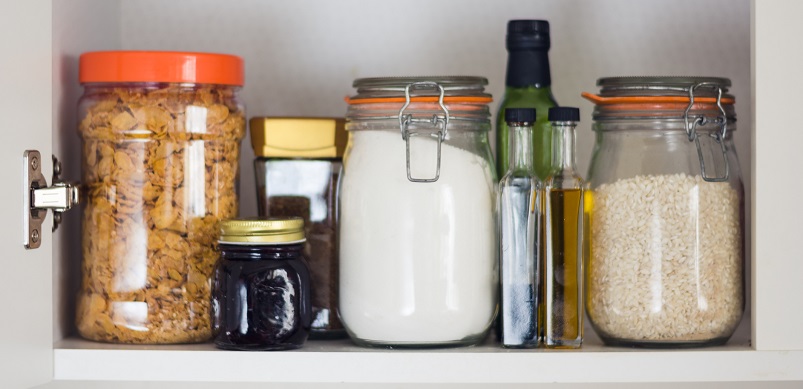
How to keep your food stored as safely as possible around your home
May 23, 2022 | Fridge Tips | No comments
Storing all of your food in the safest manner can be tricky. After all, different foods require different treatments, and it can be easy to forget what goes where in your fridge and beyond. But don’t worry! We’re here to get you in the know.
Read on to learn how to keep your food stored as safely as possible around your home. Your meats, vegetables and other edible goods will be staying fresher for longer in no time!
How to organise food in your fridge

Let’s start with the basics. When putting your food away, it’s important to know which items go on which shelf inside your fridge. Otherwise, you could end up with problems like cross-contamination from your meats, and that’s the last thing you want! Here’s a basic guide for where different kinds of food should go in your fridge for safe storage:
- Top shelf: This is where you should store all your ready to eat foods and snacks. These are the last foods you want getting dripped on or contaminated by other foods, so be sure to keep them high and out of the way.
- Middle shelf: This is where you should keep eggs, milk and dairy products, not in the door like many believe. The temperature is more consistent in the middle of your fridge than the door (which gets opened and closed a lot), so dairy items stay fresher for longer here.
- Bottom shelf: Here is where you want to store your meats. As meats can drip and cause cross-contamination with ready-to-eat foods, it’s best to keep them on the bottom shelf where they can’t do any harm.
- Drawers: As the drawers are the coolest part of your fridge and best for humidity control, this is where you want to keep your fruit and veg. These are foods you want to keep fresh for the longest, and they’ll be sheltered from cross-contamination in the drawers too.
- Doors: As we mentioned before, the fridge door is where the temperature fluctuates the most. That’s why it’s best to store items such as condiments, drinks and water here. Basically, any items that are less likely to go off!
Further tips for freshness

Following the guide above, you can rest assured that your food is safely stored in the correct manner. That being said, there are plenty of other ways to keep your food storage areas safe and your food fresh for longer! Here are a few additional tips you might want to take note of, especially when the weather is warming up and food goes off quicker than usual:
- When refreshing your fridge, it’s always a good idea to go through all of your items and throw out anything that’s past its best. Check the use-by dates on your packaged food, and throw away any other items that have been there for a while and you’re no longer sure about.
- Try some accessories to keep your fridge and food fresh for longer. A fridge odour absorber is a great way to battle bad smells, for example, and fridge protection mats can work wonders with absorbing moisture to extend the lifespan of your fruit and veg.
- Make sure you aren’t storing anything in the fridge that doesn’t belong there, as this can lead to clutter and ultimately more mess. Items such as eggs, onions, avocados and more don’t actually need to be refrigerated, so familiarising yourself with what does or doesn’t belong in your fridge can go a long way in maintaining it to a high standard.
- Fill your fridge up the right amount. As a general rule of thumb, a fridge regulates its temperature best when it’s about three-quarters full. Staying close to this level of fullness will help to keep your fridge at the right temperature, allowing your food to stay fresh for longer. If it’s nearing big shop day and the fridge is looking a little empty, place a couple of bottles of water in there to keep it a little fuller!
Beyond the fridge…

Of course, your fridge isn’t the only place you keep food, nor is it the only place you should keep an eye on. Whether it’s your pantry, cupboards or anywhere else, there are plenty of dry foods that also require a certain level of vigilance too. Here are a few more tips to help you keep your non-refrigerated foods nice and safe:
- Ditch the plastic. Keeping food in plastic bags can cause items to go off more quickly than they otherwise would, especially for non-refrigerated fruits and vegetables. Alternatively, storing food in item-specific bags or containers made of the correct materials can go a long way in preserving your food.
- Keep them out of reach of pests! Creepy crawlies and rodents can be a real pain, especially during summer. Make sure your dry foods such as rice, potatoes, cereals and the like are kept elevated wherever possible. This will make them harder to reach and reduce the likelihood of pest infestation.
- Stock up on pest control. No matter how hard you try to pest-proof your home, there’s always a chance some will get inside and make for the nearest food cupboard. That’s why keeping pest control at the ready, such as ant and fly killers, can be an effective pre-emptive strike. Better to be safe than sorry when the bugs come marching in!
Hopefully, this guide has told you everything you need to know to store your food as safely as possible. However, you can never know too much! Head over to our blog post on refreshing your fridge to learn all about how long certain foods last… and when the time has come to chuck them out!
Tags: Food safety, fridge advice, Fridge Maintenance, Fridge Tips

